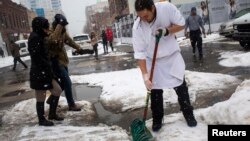WASHINGTON —
Severe weather across much of the United States took a toll on shopping and consumer spending in recent weeks, leading to slower economic growth or outright contraction in some areas of the country, the Federal Reserve said on Wednesday.
The Fed, in its anecdotal Beige Book report, said economic activity in January and February shrank slightly in two of its 12 districts, New York and Philadelphia, mostly due to “unusually severe weather.”
Growth slowed in Chicago and activity was stable in Kansas City. While the other eight districts reported growth, the Fed said it was characterized as “modest to moderate” in most cases, an overall downgrade from its last report on January 15, which showed “moderate” growth in nine regions.
But the report, which is based on information on business activity collected from contacts nationwide, showed business contacts were still upbeat, with real estate picking up in some areas and travel and tourism remaining strong.
“The outlook among most districts remained optimistic,” the Fed said.
Severe snowstorms have hit large parts of the Northeast, Midwest and Upper Midwest this year, with unusual ice storms in the Southeast as well.
But Fed officials have said it will take a major change in the economic outlook to alter plans to wind down the central bank's asset purchases, which have already been trimmed to $65 billion a month.
The Fed's policy-setting committee meets on March 18-19.
Retail sales growth softened in most districts, partly due to weather, but winter storms also had a positive effect on demand for weather-related goods in Richmond, Chicago and Minneapolis, the report said.
The word “weather” is used 119 times in the report, compiled by the Federal Reserve Bank of Atlanta from data collected before February 24, and “snow” or a derivative of snow is used 24 times. The word “ice” appeared twice.
The Fed said the poor weather dragged on jobs growth in Boston, Richmond, and Chicago, but employment levels improved gradually for most districts.
Price pressures remained subdued, although there was some upwards pressure for energy and construction products, the report said.
The Fed, in its anecdotal Beige Book report, said economic activity in January and February shrank slightly in two of its 12 districts, New York and Philadelphia, mostly due to “unusually severe weather.”
Growth slowed in Chicago and activity was stable in Kansas City. While the other eight districts reported growth, the Fed said it was characterized as “modest to moderate” in most cases, an overall downgrade from its last report on January 15, which showed “moderate” growth in nine regions.
But the report, which is based on information on business activity collected from contacts nationwide, showed business contacts were still upbeat, with real estate picking up in some areas and travel and tourism remaining strong.
“The outlook among most districts remained optimistic,” the Fed said.
Severe snowstorms have hit large parts of the Northeast, Midwest and Upper Midwest this year, with unusual ice storms in the Southeast as well.
But Fed officials have said it will take a major change in the economic outlook to alter plans to wind down the central bank's asset purchases, which have already been trimmed to $65 billion a month.
The Fed's policy-setting committee meets on March 18-19.
Retail sales growth softened in most districts, partly due to weather, but winter storms also had a positive effect on demand for weather-related goods in Richmond, Chicago and Minneapolis, the report said.
The word “weather” is used 119 times in the report, compiled by the Federal Reserve Bank of Atlanta from data collected before February 24, and “snow” or a derivative of snow is used 24 times. The word “ice” appeared twice.
The Fed said the poor weather dragged on jobs growth in Boston, Richmond, and Chicago, but employment levels improved gradually for most districts.
Price pressures remained subdued, although there was some upwards pressure for energy and construction products, the report said.









